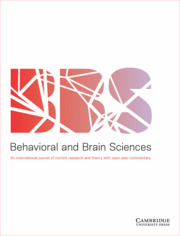No CrossRef data available.
Article contents
An epistemological account of visual consciousness
Published online by Cambridge University Press: 15 June 2005
Abstract:
O'Regan & Noë's (O&N's) explanation of our stream of experience as activities depends on their denial of that palpable, most real aspect of experience: what they call “qualitative experience.” Given the ontological primacy of the qualitative givenness of our experience and the complete absence of actions as experiences in our stream of consciousness, though, all such reductionistic attempts must fail.
Information
- Type
- Continuing Commentary
- Information
- Copyright
- Copyright © Cambridge University Press 2004
Footnotes
Commentary on O'Regan & Noë (2001). A sensorimotor account of vision and visual consciousness. BBS 24(5):939–1031.
References
Bridgeman, B. (1983) Mechanisms of space constancy. In: Spatially oriented behavior, ed. Hein, A. & Jeannerod, M., pp. 263–79. Springer-Verlag. [BB]CrossRefGoogle Scholar
Bridgeman, B., van der Heijden, A. H. C. & Velichkovsky, B. M. (1994a) Visual stability and saccadic eye movements. Behavioral and Brain Sciences 17:247–58.[BB]CrossRefGoogle Scholar
Bridgeman, B., van der Heijden, A. H. C. & Velichkovsky, B. M. (1994b) How our world remains stable despite disturbing influences. Behavioral and Brain Sciences 17:282–92.[BB]10.1017/S0140525X00034634CrossRefGoogle Scholar
Courtney, S. M., Petit, L., Maisog, J. M., Ungerleider, L. E. & Haxby, J. V. (1998) An area specialized for spatial working memory in human frontal cortex. Science 279:1347–51.[NO]CrossRefGoogle ScholarPubMed
D’Esposito, M., Detre, J. A., Alsop, D. C., Atlas, R. K. & Grossman, M. (1995) The neural basis of the central executive system of working memory. Nature 378:279–81.[NO]10.1038/378279a0CrossRefGoogle ScholarPubMed
Deubel, H., Schneider, W. & Bridgeman, B. (1996) Postsaccadic target blanking prevents saccadic supporession of image displacement. Vision Research 36:985–96.[BB]10.1016/0042-6989(95)00203-0CrossRefGoogle ScholarPubMed
Fuster, J. M. (1997) The prefrontal cortex: Anatomy, physiology and neuropsychology of the frontal lobe. Lippincot-Raven.[NO]Google Scholar
Hoaglund, H. (1966) Some bio-chemical considerations of time. In: The voices of time, ed. Fraser, J. T.. Braziller. [SER]Google Scholar
Miller, G. A., Galanter, F. & Pribram, K. H. (1960) Plans and the structure of behavior. Holt.[NO]10.1037/10039-000CrossRefGoogle Scholar
Nottale, L. (1996) Scale relativity and fractal space-time: Applications to quantum physics, cosmology and chaotic systems. Chaos, Solitons and Fractals 7:877–938.[SER]10.1016/0960-0779(96)00002-1CrossRefGoogle Scholar
Noton, D. & Stark, L. (1971) Eye movements and visual perception. Scientific American 224(6):35–43.[BB]Google ScholarPubMed
O’Regan, J. K. & Noë, A. (2001) A sensorimotor account of vision and visual consciousness. Behavioral and Brain Sciences 24(5):939–73.[BB, NO, SER, PDS]10.1017/S0140525X01000115CrossRefGoogle ScholarPubMed
Osaka, N. (2003) Working memory-based consciousness. In: Neural basis of consciousness, ed. Osaka, N., pp. 27–44. Benjamin. [NO]10.1075/aicr.49.05osaCrossRefGoogle Scholar
Osaka, M., Osaka, N., Kondo, H., Morishita, M., Fukuyama, H., Aso, T. & Shibasaki, H. (2003) The neural basis of individual differences in verbal working memory: An fMRI study. NeuroImage 18:789–97.[NO]CrossRefGoogle ScholarPubMed
Owen, A. M., Downes, J. J., Sahakian, B. J., Polkey, C. E. & Robbins, T. W. (1990) Planning and spatial working memory following frontal lobe lesions in man. Neuropsychologia 28:1021–34.[NO]10.1016/0028-3932(90)90137-DCrossRefGoogle ScholarPubMed
Petrides, M., Alivisatos, B., Evans, A. C. & Meyers, E. (1993) Dissociation of human mid-dorsolateral from posterior dorsolateral frontal cortex in memory processing. Proceedings of the National Acamemy of Sciences USA 90:873–77. [NO]10.1073/pnas.90.3.873CrossRefGoogle ScholarPubMed
Robbins, S. E. (2000) Bergson, perception and Gibson. Journal of Consciousness Studies 5:23–45.[SER]Google Scholar
Robbins, S. E. (2001) Bergson's virtual action. In: Virtual reality: Philosophical issues, cognitive foundations, technological implications, ed. Riegler, A., Peschl, M., Edlinger, K. & Fleck, G.. Peter Lang Verlag. [SER]Google Scholar
Robbins, S. E. (2002) Semantics, experience and time. Cognitive Systems Research 3:301–37. [SER]10.1016/S1389-0417(02)00045-1CrossRefGoogle Scholar
Robbins, S. E. (2004) On time, memory and dynamic form. Consciousness and Cognition 13:762–88.[SER]10.1016/j.concog.2004.07.006CrossRefGoogle ScholarPubMed
Shallice, T. (1988) From neurophysiology to mental structure. Cambridge University Press.[NO]10.1017/CBO9780511526817CrossRefGoogle Scholar
Smith, E. E. & Jonides, J. (1997) Working memory: Review from neuroimaging. Cognitive Psychology 33:5–42.[NO]10.1006/cogp.1997.0658CrossRefGoogle ScholarPubMed
Zihl, J., von Cramon, D. & Mai, N. (1983) Selective disturbance of movement vision after bilateral brain damage. Brain 106:313–40.[NO]10.1093/brain/106.2.313CrossRefGoogle ScholarPubMed

